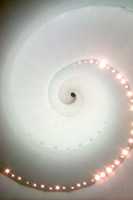Independence Temple

The Temple in Independence, Missouri, is a house of worship and education "dedicated to the pursuit of peace".[1] It dominates the skyline of Independence, Missouri, USA, and has become the focal point of the headquarters of the Community of Christ (formerly the Reorganized Church of Jesus Christ of Latter Day Saints[2]). The temple was built by the Community of Christ in response to a revelation presented to their 1984 World Conference by then church prophet-president Wallace B. Smith. This revelation culminated instructions shared over the course of more than 150 years by prior prophet-presidents recognized by the Community of Christ. Groundbreaking for the temple took place Friday 6 April 1990, and the completed structure was dedicated on Sunday 17 April 1994.
Structure and building

The public is welcomed to the temple, where there is a Daily Prayer for Peace at 1:00 p.m. Central Time on behalf of a selected nation of the world. A meditation chapel with paintings by Jack Garnier of the Sacraments being performed around the world opens onto a Japanese style meditation garden and serves the needs of individuals or small groups of visitors. The temple also contains the church archives, the Temple School, administrative offices of church headquarters, theaters used for visitors and also for meetings, presentations, and classes, a museum and gift shop. The building has become a popular attraction with guided tours available. Approximately 60,000 people visit the temple each year.
Temple ministries

The temple is regarded as a symbol of the church's mission and has long been closely associated with the denomination's developing theology of Zion, or the peaceable Kingdom of God, first advocated as basileia tou theou by Jesus Christ. The first major event held at the Temple prior to its dedication, was the International Women's Conference in June 1993. The Temple has no private ceremonies and is open to everyone. The sacraments performed there are Communion, Administration to the Sick (Laying on of Hands), and Ordination. Initially, six temple ministries centers were created in response to the building of the Temple. The temple according to Ken Robinson, former member of the First Presidency,"gives form to our commitment to Jesus Christ" and that it "is at the center of meaning and identity for members of the Community of Christ" [4]
Temple lot
Wallace B. Smith's great-grandfather and founder of the Latter Day Saint movement, Joseph Smith, visited Jackson County in 1831 and prophesied that a temple to the Lord would be built there.[5] The early Latter Day Saints purchased a 73 acres (30 ha) parcel of land known as the "greater temple lot." At that time a portion of the property was dedicated as the site for a temple, and cornerstones were laid. However, the church members were driven from the county before any construction began. The original temple site proper is now owned by the Church of Christ (Temple Lot).
The Community of Christ's temple is built on the greater temple lot, as is the Auditorium, the headquarters chapel of the Church of Christ (Temple Lot) and a visitor center from The Church of Jesus Christ of Latter-day Saints.
The Community of Christ also owns the temple in Kirtland, Ohio, the first temple actually built (rather than merely planned) by the Latter Day Saint movement, which continues to be a place of worship and education. As part of its educational ministry that site is open as a National Historic Landmark.
Notes
- ↑ Doctrine and Covenants, Section 156:5
- ↑ Questions and Answers on Church Name Change
- ↑ Chiat, Marilyn; North American Churches, Publications International, Ltd.:2004, p. 72.
- ↑ Robinson, Kenneth N., "A People of the Temple," The Herald, July 2006, p. 12.
- ↑ Doctrine and Covenants (Community of Christ), Section 57:1d
References
- Laurie Smith Monsees, The Temple: Dedicated to Peace, Herald House: 1993. ISBN 978-0-8309-0648-2
- Marilyn Chiat, North American Churches, Publications International, Ltd.: 2004, p. 72.
- Michael J. Crosbie, Architecture for the Gods. (Watson-Guptill Publications: 2000), pp. 66–72. ISBN 0-8230-0290-X
External links
 Media related to Independence Temple at Wikimedia Commons
Media related to Independence Temple at Wikimedia Commons- Temple pipe organ
| ||||||||||||||||||||||||||||
Coordinates: 39°05′27″N 94°25′35″W / 39.09083°N 94.42639°W
